By Jeffrey A. Rendall; Photos By David Vier
ST. MICHAELS, MD – Here’s a question for you golf trivia aficionados: name a state where there’s a Pete Dye designed golf course named Harbourtowne, which is well respected and was one of his very first projects?
A no-brainer, right?
Well, if you guessed South Carolina (Hilton Head Island), you’d be only partially correct, because there are actually two Pete Dye creations that share the name Harbourtowne – the famous lowland South Carolina course (with no ‘e’ at the end of Harbourtown) that hosts the PGA Tour’s annual Heritage Classic (after the Masters), and the ‘other’ being Harbourtowne Golf Resort in St. Michaels, Maryland, along the eastern shore of the Chesapeake Bay.
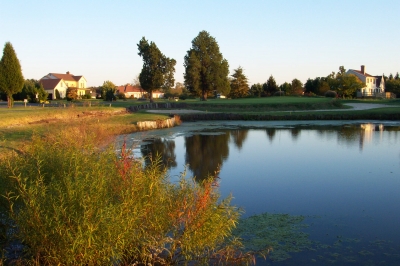 |
| Harbourtowne Resort's par three 17th hole is vintage Dye -- railroad ties and hazards. |
Though the two courses with the same name are hundreds of miles apart, there are some other similarities. As mentioned above, both were designed by Pete Dye, both came early in his career, both are target-oriented, shot-maker’s courses, and both will have you muttering to yourself about what the designer must’ve been thinking, at times.
Thankfully, both Harbourtown(e)s are decidedly worth playing – and although the South Carolina version is strongly entrenched in most publications’ world ‘Top 100’ courses lists, the lesser known Harbourtowne will come much less dear to the dollar. It’s also not saying that the Maryland Harbourtowne course shares the same category of golf experience as the legendary southern layout, but it’s still worth the trip.
And judging by the atmosphere at the resort, they’re not trying to make it the exalted golf experience either – that would be a bit too noisy and pretentious for this part of the world. Harbourtowne Resort is just a quiet, relaxing, peaceful place to play golf.
John Mlynarski, Harbourtowne’s Head Golf Professional, says atmosphere is everything: “When people ask what sets us apart from other resorts, you certainly look at our location, right here on the Chesapeake Bay. Every sleeping room at the hotel is not just ‘water view,’ it’s ‘water front.’ It’s quiet, there’s the water, and it’s just very relaxing all around. I’ve been here seventeen years, and I’ve loved every minute.”
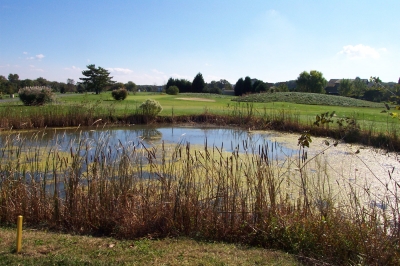 |
| Despite it's relatively mild slope rating, Harbourtowne isn't lacking for hazards. Here, the 1st hole. |
It’s easy to see where Mlynarski’s coming from. Though the golf course itself doesn’t touch the water (or even see it), the overall feeling of the property is one of a small, close-knit, calm resort experience. Just across the water lies the never-ending political and business turmoil that is the National Capital area, but once your proverbial boat’s safely docked at Harboutowne in St. Michaels, your troubles are literally an ocean away.
“St. Michaels is so laid back that a lot of couples will come down here – the guys will play golf and their wives will shop the whole time they’re here. They’ll come for three days and play unlimited golf and the ladies enjoy spending time in town,” Mlynarski said.
Or, the couples can play the course together, then go shopping. Either scenario seems to work well.
The course and resort opened in 1971, and has gone through a couple ownership changes since its inception (the current owners since 1991). According to Mlynarski, the layout and resort needed some upgrades prior to the current owners coming in, and they’ve spent generously to improve the course and the hotel. The golf course was originally named for the community surrounding it, Martingham Golf Course, and was subsequently changed to its present moniker in the early 80’s.
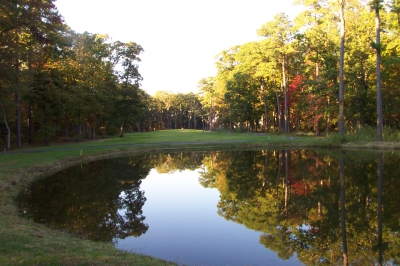 |
| The 483 yard, par five 14th is one of the more unusual holes you'll ever see. If you're in play off the tee, it's probably reachable in two. But if you miss on either shot, bogey's a good score. |
And though Pete Dye hasn’t made any changes to the layout since it was built, he did drop by a few years back to see what it looked like. Mlynarski describes the visit: “Dye stopped by a few seasons ago, took a look at the course, then we sat down to lunch. He was talking about how the resort started out, and it was pretty interesting to hear about the origins of our property.”
“Dye said when he first came here, he thought he was going to have the perimeter of the land to place the golf holes – but that space was reserved for the best home sites. So he had to do a bit of a re-design to work on the interior of the property. He said it’d changed quite a bit from the old days – that’s understandable,” Mlynarski said.
Time alters the land, even in a place as timeless as St. Michaels. The town itself was founded prior to the American Revolution, and quickly flourished as a seaport and in the ship building industry. Many historic buildings remain, making it a great place for history buffs as well as maritime and water-sports enthusiasts.
St. Michaels may have retained its historic look, but the golf course literally ‘grew up’ from infancy. Mlynarski said Dye mentioned some subtle changes from the original – a few places where there used to be a sand bunker, and now it’s a pond (there was a recent upgrade that worked on course drainage, so there’s more water on the course than there used to be). But the biggest difference has to be the trees.
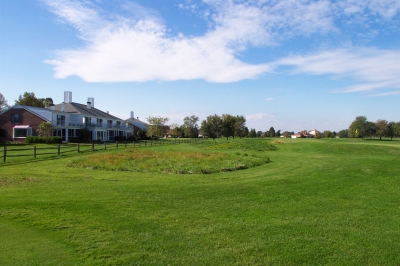 |
| From behind the 2nd green, you can see the lush conditions and open nature of Harbourtowne's front nine. |
Granted, this reviewer never saw the course at first opening, but now it’s got some holes that are as narrow as you’re going to find anywhere. Mlynarski said it used to be even tougher, before they took out several of those deciduous monsters: “A few years ago, we decided a couple spots were getting a little too tight – where trees were squeezing the landing areas so close that if you didn’t hit a perfect drive, you wouldn’t have a shot at the green. The 10th hole is a perfect example. It had large oak trees on both sides that we removed so that at least now, you’ve got a fighting chance to play the hole.”
It’s still tight. If you play the tenth from the back tee, a large tree juts in from the left – and of course, if you miss right, you’ve got problems over there, too.
They’re not shy about it, Mlynarski says it’s target golf. “You’ve got to keep the ball in the fairway to score, then you’ve got to be pretty precise with your approach shots because the greens are tiny. For a couple years, our membership’s wanted us to put different colored flags on the greens to mark front-middle-back pin placements. Well, we thought it just wasn’t necessary, because basically, on most of the greens, if you’re on the putting surface, you’ve got a birdie putt.”
There are a couple holes where the different colors help, and Mlynarski relented on the flag color issue. It’s good to keep the customers happy, right?
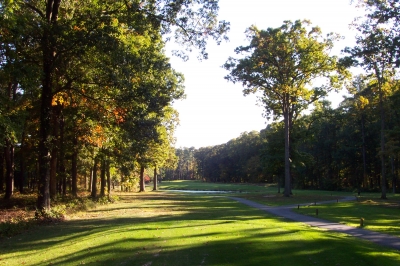 |
| Looking from the back tee box on the 10th hole. Here, you'd better be able to shape a shot and get a little luck at the same time. |
The course won’t do much for your handicap, though. Even the back tees only play to a 120 slope, which I found hard to believe. You won’t accumulate a ton of penalty shots at Harbourtowne, but if you’re chipping back to the playable areas from the woods, that’s just the same as a penalty.
One place you get a ‘break’ is the course conditioning. Mlynarski says a great deal of resources goes into playing surfaces, and sure enough, they were in very good shape, even in the shady areas. Of particular note is the bunker sand – nice, playable sand and very well maintained. Being in a Dye bunker is never a pleasure, but at least getting out isn’t hindered by poor sand.
It may be obvious from the discussion above, but Mlynarski gives you the key to scoring well at Harbourtowne: “With the excellent conditions on the course, if you’re hitting the ball well and you’re a decent putter, you can score here. We trim the rough to a manageable height, so missing a bit won’t hurt you that much. Keep it in play, and get it on the green, because the greens are conducive to good putting. They’re true, not lightning fast, and they’re not slow. They’re at the pace where you can score.”
I’d also recommend, on each hole, check the scorecard for the layout of the hole. It’s not always obvious from sight where the trouble is, so don’t hit what you think is a great shot, only to find you’re not where you want to be.
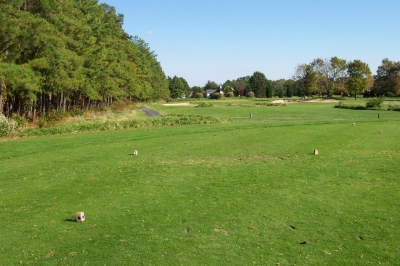 |
| The par three 7th hole will test your ability to place a short iron. Dial it in there and get your birdie. |
With all this talk of tightness and trees, you might get the impression the whole golf course is a trip through a traffic tunnel. Not true. In fact, the first nine holes are more or less wide open, with some bordering out of bounds (residences) and some water hazards and tall grass to keep you honest and frame the landing areas.
Particular favorites were numbers four and eight. The fourth hole is a 187 yard par three with a large bunker fronting a horseshoe shaped green. Mlynarski was correct that most of the putting surfaces on the course are pretty small, but this one wasn’t one of them. If you’re on the wrong spot on the green, three putts are likely, too.
The eighth hole is the front nine’s hardest hole. At 428 yards, it’s Harbourtowne’s longest par four, where you’ll need a straight, long drive, then a nicely placed second shot into a large, slightly elevated green. Tough hole.
Holes ten through fourteen are the tight ones. Mlynarski recommends that players use an iron off the tee, just to get the ball in play. Three of these holes are over 410 yards, but that’s sound advice. Better a long iron or fairway wood to approach the wider green complexes than challenge the narrow fairways. Let the short game take care of the rest.
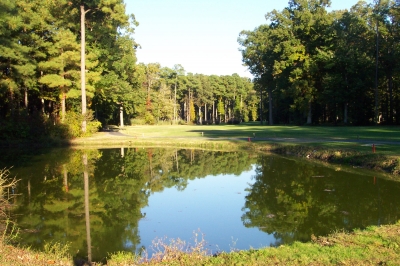 |
| At 351 yards, the par four 13th is all placement off the tee and for your second shot. |
Harbourtowne’s signature hole would have to be seventeen. Only 164 yards from the tips, you’re shooting over water to a well protected green fronted by a huge bunker and in back by trees and sloped sides. It apparently used to be completely surrounded by trees, but Mother Nature has eliminated most of them.
As you’d probably guess, golf isn’t the only thing offered on the 153 acre resort property. Non-golf activities include tennis, biking, softball, volleyball and a fitness center, amongst others. Bay oriented activities are also available, and restaurants include the Bayside Restaurant or Club House.
Harbourtowne Resort’s a nice place to get away from the Washington DC hustle-bustle. Don’t go there expecting the ultimate Pete Dye golf experience, or to be wowed by man-made landmarks such as the ‘other’ Harbourtown’s lighthouse. But if you’re looking for a close-by, peaceful piece of earth with some no-stress golf and a nicely accented small resort, this is a great place to start.
Where To Stay (If not at the resort)
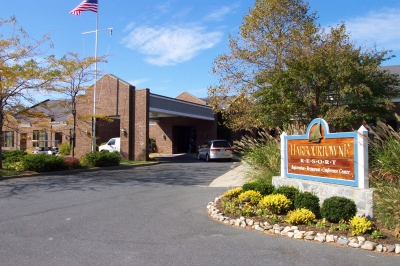 |
| Harbourtowne Resort is more than just golf. Enjoy the relaxing atmosphere. |
On our visit, we stayed at the Harbour Inn, Marina and Spa. As the name implies, it’s right on the St. Michaels marina, and we could literally walk out the sliding glass door from our room and be at the Marina.
The Harbour Inn offers several different types of accommodations (46 rooms total), from traditional hotel rooms (called ‘Guest Quarters’) to luxurious suites including wet bar, balcony and Jacuzzi tub. Ours was a one bedroom suite complete with two queen size beds and a spacious sitting room and a wet bar area that included a refrigerator. We’ve found on our travels that having access to a refrigerator is a valuable convenience, indeed!
Amenities include harbourside pool, whirlpool and exercise room, as well as restaurant and tavern.
New amenities include a Spa (opening April, 2004). We didn’t get to try it, but it looks spectacular!
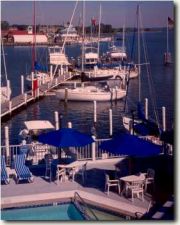 |
| Marina views in abundance at the Harbour Inn. |
The staff was courteous, the location very convenient to the town (and the golf at Harbourtowne Resort), and the views were outstanding. No better place to enjoy the charming ambiance that is St. Michaels.
For more information on the Harbour Inn’s offerings and reservations, try their website: www.Harbourinn.com, or call (800) 955-9001.
Details:
Rt. 33 at
Phone: (800) 446-9066; (410) 745-9066
FAX: (410) 745-9124
Website: www.harbourtowne.com
Course Designer: Pete Dye
Head Golf Professional: John Mlynarski, PGA
Tees/Yardage (par 70)/Slope/Rating
Blue 6320 120/69.5
White 6128 118/68.3
Gold 5597 115/66.3
Red 5036 113/68.5
Rates:
$65 to play the golf course, includes cart, greens fee and all taxes. Wintertime, from November 15 to March 15, the rate is $42.50.
Needless to say, many golf packages available with a hotel stay.
| Related Links | Comments on this article? | |
|
Maryland National Golf Club Hollow Creek Golf Club Rocky Gap Resort PB Dye Golf Club in Ijamsville Whiskey Creek Golf Club |
E-mail Jeff Rendall, Editor: jrendall@golftheunitedstates.com |











